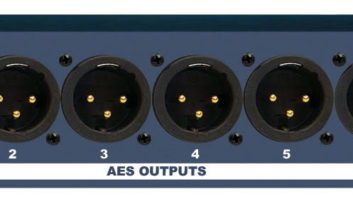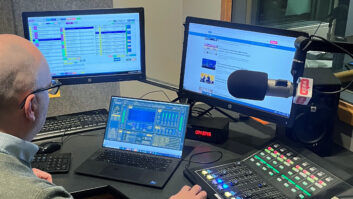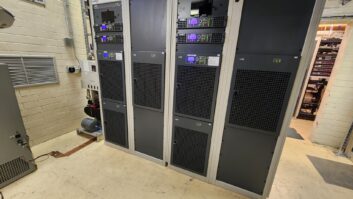Editor’s Note: The following article is a bit of a departure from the usual “deep tech” topical treatments that are the norm for these pages. VoIP technology, while not exactly new, is just now starting to make real inroads into broadcast facilities, and it is most often the task of engineers to justify making the investment in the required equipment. With that in mind, I asked Kirk Harnack, senior solutions consultant for the Telos Alliance, to provided RWEE readers with the tools they need to make an initial evaluation and also to “speak the language.”—Cris Alexander, Technical Editor, RWEE
“IP-delivered telecom service will produce a 100 percent ROI in two to three years.” That’s a strong message to deliver to station management. If it’s true, the engineer earns new level of respect and confidence. If phone calls and outside remotes sound better, it’s good for both talent and listeners. And, if required maintenance goes down, that’s good for engineering.
SIP/VoIP telecom service usually saves a significant amount each month compared to the legacy telecom service it replaces. This can mean a great deal of savings in a relatively short period of time, and that in turn can result in a new on-air phone system quickly paying for itself.
A new IP phone on-air phone system will make every caller sound better and allow HD Voice calls from station employees and VIP callers.
Actual MRC savings will be different for every broadcast facility, as will the amount of hardware involved in a new SIP on-air phone system, but every broadcaster can see a reasonable ROI period by upgrading to new telecom technology.
While inflation still plays a role by increasing costs incrementally year after year, costs associated with commodity technologies tend to go down over time. Some have gone down dramatically.
TECHNOLOGY AND TELEPHONY COSTS DECREASING
In constant dollars, for example, the cost of a premium cell phone has decreased about 90 percent since the mid-1980s. Large color TVs have come down more than 50 percent since 1980. Budget computers sell for 10 percent of what they did around 1979, yet they do so much more. Even a typical Mac desktop computer, in constant dollars, costs 75 percent less than in the late 1970s.
Similarly, voice and data connection technology has progressed markedly, bringing significant cost reductions. Circuit-switched connections for voice and dedicated data lines — from local monopoly providers — are steadily being replaced with packet-switched voice and Internet Protocol (IP) data connections, often from competitive providers (CLECs). Legacy POTS (Plain Old Telephone Service), T1 and ISDN PRI lines still bring phone service to many broadcasters; their costs continuing upward, especially when those connections come from the Incumbent Local Exchange Carrier (ILEC).
We’ll examine typical costs and savings shortly, but first let’s consider how we got here.
Think back to earlier days of business telephony. Broadcasters were forced to buy their phone connectivity the same way they purchased other services such as electricity, natural gas and water — from a monopoly provider. Even after the telephone monopolies were somewhat broken up in the late 1980s, things didn’t change very much because the technology was still the same.
Broadcast engineers at the time may not have realized it, but we were severely constrained by the analog and TDM circuit-switch technology of the day and what it offered. With the introduction of Voice over Internet Protocol (VoIP), voice calls can be converted into data packets just like any other data traveling over IP networks, including the Internet. Since they use a common and open standard, the VoIP packets can interact with practically any other internet-based data system.

Fig. 1: Market share of services
This might not sound like a big deal, but in reality, it’s changing everything. Since VoIP packets are handled the same way as other IP-based data packets, companies are creating VoIP applications that are best suited to their own needs. This includes broadcasters and their on-air talk show systems.
Voice and data over IP connections continue growing every year. In a quarterly earnings report from February 2016, Cincinnati Bell said, “We are seeing a heavier adoption especially on the business side of VoIP lines, which is just a migration from (TDM) access to VoIP lines. We see that staying pretty constant.” See Fig. 1.
NEW REPLACES OLD
Broadcasters save money by replacing older phone and leased lines (T1 or ISDN-PRI circuits, etc.) with newer IP-based services. Older phone and leased lines typically come from the ILEC in your area.
For many locations in the USA, this will be AT&T, Verizon, or perhaps CenturyLink, Cincinnati Bell, Fairpoint, Sprint or Frontier. These ILECs have typically been slow to offer alternatives to their traditional, tariffed services. Moreover, ILECs’ traditional services often have myriad federal, state, and local taxes tacked on.
Competitive Local Exchange Carriers (CLECs) must also charge taxes for equivalent services. However, CLECs have been more nimble, introducing IP-based connections along with voice and data services.

Fig. 2: IP-based telephone service
We’ll see both specific and hypothetical cost examples below. In general, though, a broadcast facility will replace POTS and/or T1/PRI circuits from their ILEC with IP-based connections from a CLEC or other IP provider. This IP connectivity may be either a dedicated IP connection (specific to VoIP, often called “Managed SIP”) or may arrive over an existing, enhanced, or new Internet-facing IP connection (see Fig. 2). There are several options, and rarely will two broadcast facilities be alike in their new VoIP connection plan.
While replacing traditional telephony connections with new, IP-based ones, a broadcaster likely will also replace the on-premise phone system. This may include the business phone system and/or the on-air phone system(s). Here is where a calculation of Return on Investment comes in.
While this article mainly concerns the on-air phone system, similar calculations can be done for a business-facing system. Indeed, many broadcasters are choosing to use a single — or perhaps redundant — VoIP phone system(s) to serve both business and on-air needs. The engineering expertise needed to install and maintain one easily applies to both.
TELECOM AND ROI GLOSSARY
Asterisk — You may hear “Asterisk” spoken in reference to IP-PBX phone systems. Wikipedia says, “Asterisk is a software implementation of a telephone private branch exchange (PBX); it allows attached telephones to make calls to one another, and to connect to other telephone services, such as the public switched telephone network (PSTN) and Voice over Internet Protocol (VoIP) services. Its name comes from the asterisk symbol, *.” There are many commercial IP-PBXs that use Asterisk as their underlying software. Optional interface cards allow Asterisk-based IP-PBXs to connect with T1 and PRI legacy phone services. Regular IP-networking interfaces are used to connect to incoming SIP/VoIP services, plus all the IP phone extensions.
ISDN-PRI or just PRI — Similar to T1, except that it offers a bit more flexibility in terms of data transmission. PRI service is actually carried by T1 circuit technology. PRI service can now be delivered over IP connections and converted to PRI for customers whose equipment needs it.
ISDN-BRI or just BRI — This is a fraction of a PRI circuit. BRI is the ISDN connection that broadcasters have used for 20+ years for connecting ISDN codecs, such as the Telos Zephyr. ISDN-BRI can also be used for regular phone calls just like ISDN-PRI. Telephone companies have been phasing out ISDN-BRI by raising rates significantly and not offering installation of new BRI circuits.
Legacy — This term is used to reference older, traditional services usually provided by the Incumbent telephone company. Such services include POTS, T1, PRI, BRI and perhaps even equalized broadcast lines.
MPLS — Multiprotocol Label Switching. MPLS is a type of data-carrying technique for high-performance telecommunications networks that directs data from one network node to the next based on short path labels rather than long network addresses, avoiding complex lookups in a routing table. MPLS is an extra-cost feature offered by most Internet Service Providers to provide a guaranteed-delivery packet prioritization.
MRC — Monthly Recurring Costs. This is typically the monthly telephone bill(s). Lowering MRC provides the basis for ROI on equipment that uses newer, IP-based technology.
PBX — Private Branch Exchange. Wikipedia says, “[A PBX] is a system that connects telephone extensions to the Public Switched Telephone Network and provides internal communication for a business. An IP-PBX is a PBX with Internet Protocol connectivity and may provide additional audio, video or instant messaging communication utilizing the TCP/IP protocol stack. A modern IP-PBX can provide many automatic functions for handling incoming and outgoing phone calls. These might include voice mail, interactive voice response, outgoing least-cost routing, and “follow me” call routing. An IP-PBX can also provide one or more private conference bridges and even a legal announcement to radio station callers prior to forwarding such calls to a broadcast studio. An IP-PBX is usually installed at the broadcast station. However, it’s also possible to use a “Hosted PBX” service where the IP-PBX is “in the cloud” and all phone extensions are connected via the Internet.
POTS — Plain Old Telephone Service. This is the traditional “dial tone” phone line service. It may be delivered as analog phone lines, or can be brought in as T1 digital circuits. From a data perspective, POTS is inflexible and tends to incur every tax and restriction that regulators have thought up over the past 100 years.
ROI — Return on Investment. ROI is the benefit to an investor resulting from an investment of some resource. A high ROI means the investment gains compare favorably to investment cost. As a performance measure, ROI is used to evaluate the efficiency of an investment or to compare the efficiency of a number of different investments. In purely economic terms, it is one way of considering profits in relation to capital invested.
SIP — Session Initiation Protocol. This is simply the most popular form of using VoIP technology. SIP is a worldwide communications protocol allowing most any SIP device, such as an IP desk phone, to call any other IP desk phone. “SIP” and “VoIP” are often used interchangeably, though they have slightly different technical meanings. If a phone, IP codec or smartphone app connects using SIP, then it is by definition a VoIP device.
T1 — Invented in the early 1960s, T1 is a telephone company circuit that can bring 24 POTS lines over a set of four wires. Traditionally considered as very reliable, customers’ experiences have been somewhat poorer in recent years.
TelosVX — The TelosVX and TelosVX Prime are SIP/VoIP phone systems designed specifically for the needs of on-air broadcast operations. VX systems are designed to connect as SIP Extensions from an IP-PBX. In other words, it’s important to have an IP-PBX installed to which the VX system will connect.
VoIP — Voice over IP. This is a general term for sending and receiving voice (or other audio) over an IP connection and network. Skype, Google Hangouts, Facetime and IP phones are each examples of VoIP at work. With proper consideration given to the IP connections involved, VoIP can be just as reliable as legacy telco connections such as POTS and ISDN.
IMPETUS FOR CHANGE
New equipment purchases are often justified by an examination of ROI. Such is frequently the case when considering a new on-air phone system. Almost as if by magic — or incredibly good timing — the Telos Alliance introduced the TelosVX multi-studio talkshow system at about the same time as three significant trends in the telecom industry.
1. In 2012, AT&T petitioned the Federal Communications Commission to allow the discontinuance of POTS phone service over time.
2. In 2013, Verizon was the first US carrier to announce the discontinuance of new ISDN service. Since then, ISDN customers have reported triple-digit rate increases for their monthly ISDN service.
3. SIP, the most popular VoIP protocol, has witnessed a meteoric rise in uptake. SIP’s popularity owes to three key attributes: a) Lower cost; b) Competitive supplier marketplace; c) Integration with flexible IT infrastructure.
Broadcasters may want a new on-air phone system for a variety of reasons. The legacy system might be old and unreliable. The audio quality benefits are tangible — or, certainly, audible. Close integration with broadcast audio consoles and other systems is another benefit of a networked system. But the Market Manager or the CFO is interested to see how purchasing some new equipment is going to pay off — and how soon. This is Return on Investment — ROI.
ROI CONCLUSION
The Executive Summary on SIP ROI is this: SIP telecom service typically saves from 25 to 75 percent over the MRC of the telecom services it replaces. For a small-market broadcaster with two or three radio stations, this might add up to a few hundred dollars per month. For a larger broadcaster with a half-dozen stations in a market, this figure can easily be close to two thousand or more dollars per month in telecom savings.
Monthly cash savings in either scenario will easily produce a 100 percent ROI in two to three years for a new on-air phone system covering all studios. Of course, actual MRC savings will be different for every broadcast facility, as will the amount of hardware involved in a new SIP on-air phone system.
There’s no shortage of information about reducing telecom costs with VoIP telephony. Much of it comes in the form of advertising by VoIP resellers and VoIP equipment providers. Pricing is often simplified to show a monthly cost per line or a monthly cost per user. The per-line cost is typically offered as either a base-plus-usage price, or an unlimited-usage price. Per-user (actually it’s per-extension) pricing is not as applicable to on-air broadcast scenarios.
Unlimited-use VoIP costs are typically around $20 per line per month. Baseline pricing typically starts around $7 per month, plus two to three cents per minute of use. This pricing assumes that the facility is providing IP connectivity — typically Public Internet, but it could be a dedicated local IP connection to the provider’s Point of Presence (PoP).
Compare roughly $20 per line per month with $40 to $100 per line per month for traditional Business POTS lines. Recent examples of traditional ISDN-PRI “dial tone” service indicate a cost of $65 per line per month, if one uses all 23 talk channels. That’s just under $1,500 per month for a full ISDN-PRI.
Let’s examine some actual costs as reported by broadcast engineers in some Top 100 US radio markets.
First is a large commercial cluster in a Top 50 market. By moving from ISDN-PRI to a “Managed SIP” connection, the stations are saving $900 per month, or more than $10,000 per year. Their Director of Engineering reports his clusters’ telecom savings:
“I was paying $1,500/month plus usage for a traditional PRI. I now pay $600/month flat (includes unlimited local and LD calling) using a ‘Managed SIP’ trunk. Basically it’s a service provided by a CLEC; they manage the traffic entirely on their network as VoIP. It’s more reliable than pure VoIP, but costs more.”

Fig. 3: Top-50 market example

Fig. 4: Top-75 market example
The engineer at a community station in that same Top 50 market brought in SIP trunks and installed his own SIP PBX phone system and new SIP phones. Legacy POTS phone service would have cost about $400 per month for similar capacity. Savings for this small radio operation, then, is about $250 per month. See Fig. 3.
Another station cluster in a Top 75 radio market is using a combination of PRI and SIP connections. The engineer is responsible for cost optimization not only at the main facility, but also at co-owned station clusters in two other markets within the state (see Fig. 4). Their stations were less interested in MRC savings and more focused on improving telecom and data service in each of the three market clusters they operate. These stations greatly improved their business processes and communications by moving to an IP infrastructure. Plus, they saved enough money to replace their business phone systems with VoIP equipment.
“For our business and on-air lines, we moved away from four bonded T1s for internet and three PRIs for telephone and ISDN, replacing them with just one 30 Mb/s fiber link. That was around three years ago. Our objective was to get as much guaranteed bandwidth as possible without increasing the monthly recurring costs (MRC). We went from 6 Mb/s to 30 Mb/s for about the same money.
“Now, we have added 6 Mb/s MPLS circuits to our two other markets. These tie those two smaller markets to our big market for corporate WAN access and SIP telephone service. The Asterisk PBXs in each market have dial plans that direct market-to-market calls over this MPLS to avoid toll charges. Also these circuits were much less expensive than having corporate WAN access provided to each market.”
Our final example is a station cluster in a Top 30 radio market. Their engineer notes that ISDN BRI costs “are skyrocketing” and notes, “We should have weaned ourselves off that technology years ago.” That’s a candid and truthful admission, to be sure. This station cluster is now in high gear, planning replacement IP-based service. The sooner they switch, the more they’ll save on monthly recurring costs.
“We have only a very few POTS lines, but a large number of T1s and, believe it or not, ISDN-BRIs. Some of our on-air talk show lines are direct BRI circuits. These BRI line costs are skyrocketing! Seems like every month, the charges get higher and higher. We are moving more and more off these circuits as quickly as budgets allow for new VoIP equipment. One station does at least six remotes on a weekly basis. We have a number of T1s, plus fiber into the building. And, we have ordered some additional 250-meg Internet circuits from the cable company to get us more onboard with remotes via Internet. We can no longer justify ISDN orders, which is good since we should have weaned ourselves off that technology a few years ago.”
COST COMPARISONS AND ROI
Several decades of broadcast engineering, management, and working with telecom technology have consistently revealed a common thread among all broadcast facilities: No two are alike. What we can do is demonstrate how to consider and compare existing telecom services and equipment with new IP-based services, and the equipment needed to use them.
Let’s examine two very simplistic telecom cost scenarios — one for a medium-market facility and one for a small-market facility. The services and costs shown may be wildly different from your own; every facility is different, and some staggeringly so. Nevertheless, a basic comparison on two different market scales demonstrates great promise for significant monthly cash savings when replacing old telecom services with new ones. See Tables 1 and 2.


TelosVX talkshow equipment natively uses SIP/VoIP connections, so it’s ready to take advantage of new cost-effective SIP service. As with telecom service, every TelosVX talkshow installation will be different. However, here’s a look at a typical scenario for medium- and small-market station clusters. These scenarios assume that a station already has a Livewire studio network or is about to move into the Livewire AoIP world, and that either a business PBX or standalone SIP PBX will be used with the TelosVX system. See Tables 3 and 4.


Both ROI scenarios are realistic for many Telos customers already using some Livewire AoIP infrastructure (consoles and routing). Broadcasters connecting a TelosVX on-air phone system to non-Livewire equipment will typically see a 20 to 30 percent extra one-time cost for interfacing “nodes.” This changes the ROI period to typically to just under two years.
Interestingly, some broadcasters have taken a long-term approach to their ROI on telecom savings by upgrading some or all of their audio consoles when they make the switch to SIP/VoIP phone service. The telecom savings can fully fund the whole-facility upgrade to Audio over IP (AoIP) consoles and routing when considered over a longer time frame.
NEXT STEPS
When considering a change of telecom technologies and providers, it’s important to be aware of alternative approaches to both on-air and business phone systems. We’ve focused here on the on-air side. However, combining the business and on-air considerations will likely result in further savings and efficiencies. It’s not necessary they share anything in terms of services or equipment (or, they can fully share) to realize a full slate of MRC savings.
As part of a meaningful discussion about ROI, broadcasters will want to consider the various business and technical scenarios available in bringing VoIP services to users.
The Telos Alliance has produced a video showing five ways to bring SIP/VoIP service into your on-air phone system. The video can be seen via this link: http://tls.al/VXSIPconnections. For more in-depth information about using SIP/VoIP for talk shows and call-in shows in a multi-studio environment, see this webinar about the TelosVX system: http://tls.al/VXWebinar.












